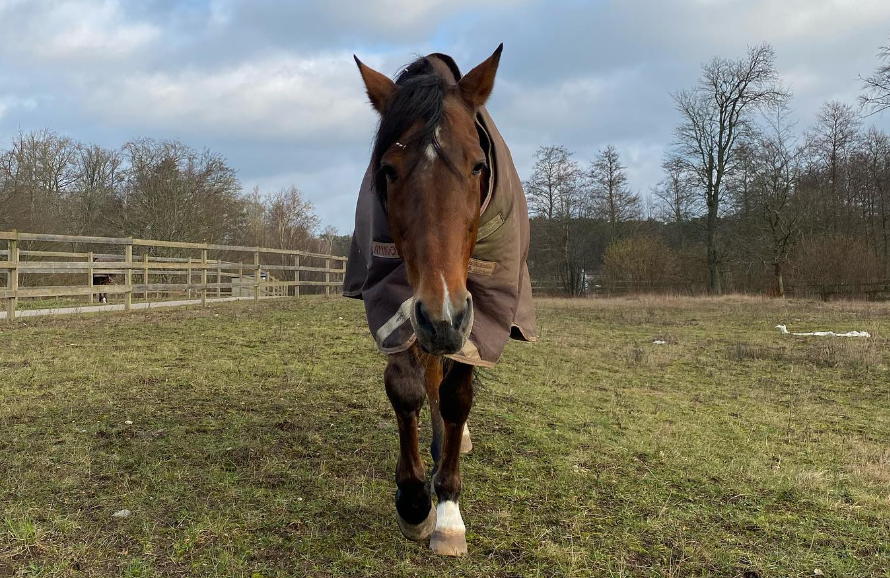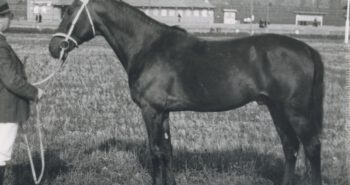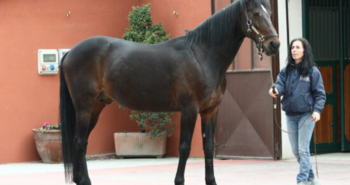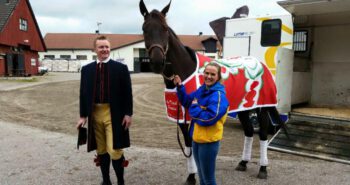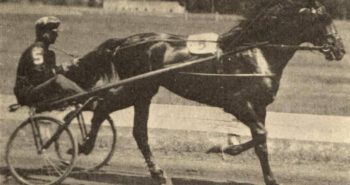He set several world records, is one of few horses to beat Varenne fair and square and went on to become one of the best stallions the world has ever seen. To his trainer, though, Viking Kronos was more than just a spectacular racehorse and stallion. He was everything. “God has created him, he’s a phenomenon. Then I have been given the great honor of taking care of him, for which I am eternally thankful”, Kolgjini said after the horse’s win in the E3 final in 1998.
When Mosaique Face impressively beat Maven and Papagayo E to win in 1.09,0 (1:51f) in Gävle one week prior to the 2015 Elitlopp, the interviewer asked trainer-driver Lutfi Kolgjini “surely this is the best horse you have ever trained?” expecting a positive answer. Kolgjini, however, immediately responded “not even close, that honor belongs to Viking Kronos.”
Exactly how high did Kolgjini rate Viking Kronos? The 1998 Hambletonian was won by Muscles Yankee who was the outstanding 3-year-old in the US crop, but Kolgjini wasn’t exactly fazed.
“Viking Kronos would beat Muscles Yankee easily even if he had to run outside him the whole race.”
Lutfi Kolgjini
Ridiculous to some, but “Ludde” meant it. Always believing in his horses, Kolgjini is a very emotional person who says exactly what is on his mind, something that has made him hated by a few but loved by most people.
To fully understand what Viking Kronos, affectionately “Vikingen”, “the Viking” in English, meant to Kolgjini one needs to briefly know the trainer’s story. Kolgjini’s family fled from Albania to Kosovo in 1948 when the communists took control, and some family members had already been killed at that time. In 1967 the family moved from Kosovo, then in Yugoslavia, to Sweden. He started working for a trainer at Jägersro in Malmo at 18 and at 25 started on his own. At a young age he was twice champion trainer at Jägersro before things started to go downhill in a negative circle: he lost some owners, the remaining horses failed to perform and his partner had left him. A very emotional person, it all culminated in a race at Jägersro in 1995 when Kolgjini deliberate drove his horse into Erik Adielsson and his horse because he felt the latter had taken a few liberties with him earlier in the race. He received a three months suspension and there was no end of negative press.
Some owners stuck by Kolgjini’s side, however. One of them was Thomas Moberg, a Swede who, together with Lars Omnell and Italian Antonio Carraretto, bred trotters under the “Kronos” breeding name at the latter’s farm in Italy. The “Kronos” venture was initially started in 1989 with Thomas Moberg and Lars Omnell, with Carraretto a 20 % partner. But when Omnell died in 1999, Carraretto became a 50 % partner while Moberg sold his part in 2002 to Kolgjini, Göran Falk and Johan Dieden.
The gamble pays off
Moberg had bought Conch in foal to Speedy Crown from Hugh Grant in 1988. That foal, King Conch, finished second in the Hambletonian and also won the Review Futurity, the Tompkins-Geers and the Hanover Hempt Stakes. Having heard so many good things about American Winner, and believing his type would be a good fit for Conch, who was not the smallest of mares, Moberg had bred Conch to American Winner in 1994, his first year at stud, and had high hopes. Telling Kolgjini that “gold may be on its way”, the trainer agreed and wanted the resulting foal badly. However, money was a big issue then. In fact, in his own words, he “could not even afford the flight down to Italy to go to the auction.” But somehow he managed to secure a deal to buy the foal, Viking Kronos, on credit.
Was it a stupid mistake or a masterstroke? In the words of Kolgjini, “3 days after the auction the horse came to my farm in Vomb. That was the first time I even saw him. Wow! He was a fantastic horse to look at. Now the big question was only, could he trot, too? Or was I in even more debt?” His partner Anna was back after their separation and now he had Vikingen there – although he did not know it at the time, it had all came come together. Breaking him in, Viking Kronos did absolutely everything right and after only 10 days Kolgjini decided to test him, something he would normally never do. What happened then he would later describe as “that feeling that he gave me that day, it was euphoria, I got goosebumps all over” and “I have had many stars in my training but nobody with that kind of talent.”
To return the generosity of his breeders, Kolgjini gave 25 % of the ownership back to the them. Looking to cash in on some of his good fortune, Kolgjini sold off part of Viking Kronos, including 30 % to Fulvio Montipo of “Scuderia Terra Reggiana”, breeder of the Italian “Rex” horses, as well as a part to Lou Guida. In his 6 races as a 2-year-old Viking Kronos set several Italian and European records – and also one World record, for 2-year-olds on 1 5/16 mile race, or “medium distance” as it is called in Europe. The wins were, like the horse itself, spectacular as Viking Kronos usually won by 20 or even 30 lengths. Kolgjini would charm the crowd and the fans flocked to see him race. His first three starts as a 3-year-old were nothing different. When in Italy, the daily training was done by Jerry Riordan who then said the following about Viking Kronos, “In working with Chuck Sylvester, I had the honor to train some of the greatest horses in the history of harness racing, including Mack Lobell. But Viking Kronos may just be the greatest 2-year-old I have ever trained, or that anyone else has ever trained. I have seen the top 2-year-olds of 1997, including those in the United States, and in my judgement, none of them is in this horse’s class. He may just go down in history as the greatest of them all if he continues on his current path. He is, by far, the best looking horse I have ever seen on a race track.”
The fight for control
But having won his first 9 races, in the warmup before his 10th start, the Gran Premio Etruria in Florence, Kolgjini immediately felt something was very wrong. What happened in the race and the aftermath was the subject of a longer program with Kolgjini on Swedish radio on July 5, 2012. To quote the trainer verbatim:
“I realized immediately that something was wrong. Vikingen behaved like a madman, he was not controllable. I had never felt him like this before. After the warm-up I asked the caretaker if he had always kept the horse, who was stabled at Montipo’s farm outside of Bologna, in his sights. Tommy, the caretaker, said he had [always kept the horse in sight] except at night. I did not know what to do, but I was hoping he could calm down. It was difficult, there were so many spectators who wanted to see him. I decided to let him race, perhaps the most difficult decision I ever made. Vikingen would never be the same. The magic disappeared that day. He finished second and for the first time ever he was dead tired after the race. Thoughts flew through my head: was he sick? was this sabotage? I decided to take the horse back to Sweden immediately and I asked Tommy prepare the trip. The day after I get a call from Tommy who said the transport was stopped by Montipo’s people. Montipo said the horse was not allowed to leave Italy. Having already checked in at the airport, I immediately rented a car and went to Montipo’s farm. With me was Lou Guida, who earlier also had bought a part of Viking Kronos.
Montipo referred to the contract which had a clause saying that the horse should be stabled at his farm as long as he is competing. I told Montipo that the horse is sick and he needs to come to Sweden so I can have complete control and figure out exactly what the problem is. Montipo refused. I refered to the contract which specified that I would be deciding for how long Vikingen would complete. I told Montipo that I had just decided to retire the horse. Montipo said his lawyers would challenge this and reminded me that in Italy such a process would easily take a year or two. In the meantime the horse would not be allowed to leave the farm, end of discussion. I was shocked, what were the alternatives? Montipo laid out the alternatives, either he bought me out or I bought him out. If I wanted to buy him out, his part in Viking Kronos would cost me 1 million dollars. I had nothing like that available. I asked him long I would have to produce that kind of money. The incredible answer was one and a half hour… Lou Guida had never said a word but now he turned to me and said we should eat lunch. We left for the nearest restaurant, but food was the farthest thing from my mind. Outside the restaurant I paced back and forth, trying to figure out what to do. Suddenly it hit me. One year earlier I had met Michael Schröer, owner of the big November stables in Germany.
“Kolgjini, I don’t give a shit if you race in pink, do the business”
Lou Guida
I got his phone number, and I was lucky that he answered right away. Would he buy Montipo’s share in Viking Kronos? Yes, he answered immediately. When he heard that the price was 1 million dollars for 30 % he wanted to think about it and discuss it over with his wife. I told him that he would never regret it and that it would be the best horse deal he would ever do. He asked me how long he had to think about it. 45 minutes, I said. Lou and I drove back to Montipo’s farm. On the way there Guida tried to convince me to let go. Cash in and get rich, he said. Guida meant well, that I am convinced of – he just wanted me to get lots of money now which would secure the future of me and my family. But I was livid at this kind of blackmail and never wanted to sell. As we parked the car, Schröer called. My heart jumped. My future was at stake. Schröer asked who would be driving the horse. Me, I answered. Could the horse please compete in the blue colors of the November stables? I laughed and posed the question to Guida, the other owner of Viking Kronos. He simply responded “Kolgjini, I don’t give a shit if you race in pink, do the business” . Guida and I walked into Montipo’s office where he asked me for my answer. I pressed the green button on my cell phone while saying “I’ll buy you out, here is somebody who wants to talk to you”. I have never seen anybody as surprised as Montipo was just then. They talked for a few minutes and I had just won the most difficult battle of my life.”
Two days later Viking Kronos came to Sweden, and Kolgjini was relieved when a thorough check-up revealed nothing wrong. A month later the horse went back to Italy for the Gran Premio Nazionale. Quite incredibly, Montipo now wanted to buy into the horse again. He had received a lot of bad press and hateful comments from fans in Italy for selling his part in the biggest trotting talent Europe had seen – and to a German at that! After a meeting where emotions flew very high and the arguments were similarly heated – and where Kolgjini refused point blank to let Montipo buy in regardless of how much he wanted to save face – in the end Schröer and Guida actually sold 10 % each to the Italian as they wanted peace and quiet around the horse. Viking Kronos won the Gran Premio Nazionale in a new world record ahead of Varenne and, according to a still irate Kolgjini, “Montipo celebrated in the winner’s circle as if nothing had happened” .
Viking Kronos then returned to Sweden, where he had been trained most of his career, for the E3 stake elimination and final, in which he toyed with the Scandinavian 3-year-olds, including Victory Tilly, and set another world record for 3-year-olds on 5/8 track. According to one source, however, “In my opinion the great athlete already at that point showed that he was suffering from problems. His excellent gait was not any longer what it had been before.”
The American Winner-son would only make one more start, in the Italian Derby where he finished a disappointing fourth. Something was clearly very wrong and after a veterinary check-up uncovered both OCD and throat problems it was decided to retire Viking Kronos to stud. Both problems required surgery and the owners did not want to take any risks with their superstar, especially not Kolgjini.
The best stallion ever?
At stud Viking Kronos immediately established himself as a great stallion in the mould of Valley Victory. Another similarity to Valley Victory was the relatively poor fertility. Hovering between 50 and 80 foals annually, he peaked at 97 foals in 2004 and 91 in 2008, but after the latter his production declined sharply. After covering only 6 mares in both 2013 and 2014, Viking Kronos was retired from stud duty. Despite this the list of get who have won races at the highest level is long. It is spearheaded by Prix d’Amerique-winner Maharajah, Triton Sund (who earned more than 15 million SEK, around $2m at the time), and stars such as Thai Tanic, Raja Mirchi, Going Kronos, Lantern Kronos, Turbo Sund, Joke Face, Fama Currit, Micro Mesh, Gift Kronos, Juggle Face and more. Viking Kronos produces both speedy and strong trotters with lots of talent and early speed, and his foals are generally very easy to handle. Many have claimed that Viking Kronos is one of the absolute best trotting stallions of all time, and it is easy to see the rationale for this.
As soon as he was done producing his sons and daughters picked up where their sire had left off in spectacular fashion. His sons Maharajah and Raja Mirchi have been awarded the coveted Elite Stallion distinction in Sweden because of their hugely impression production at stud, and the former stands out as a likely line extender with great sons like Makethemark, Moni Viking and Who’s Who. His daughters have also been great broodmares, and Viking Kronos is the damsire of Prix d’Amerique-winner Readly Express, as well as standout performers such as Attraversiamo, Cash Gamble, Coin Perdu, Heavy Sound, Nesta Effe, Princess Grif and The Bank.
Viking Kronos was inducted into the Scandinavian Trotting Hall of Fame in 2018, and lived out his life as a king at Kolgjini’s farm in Southern Sweden. He passed away on Jun 9, 2023, 28 years old.
As Viking Kronos started his stud career, Montipo, Schröer and Guida were all eventually bought out, Kolgjini instead owning the stallion together with Menhammar Stuteri – and all have made excellent money on the horse that Kolgjini initially couldn’t afford. But, Viking Kronos has not made everybody money. In 1997, Lutfi Kolgjini had some work done at his farm, but still struggling financially and not really knowing how he would pay them, he instead made them an offer they obviously could refuse: “I have acquired a fantastic stallion recently. I can give you 25 per cent ownership in this stallion for your work.” Smelling a bad deal, they declined.
Viking kronos
Bay colt born in New Freedom, PA on Feb 8, 1995. Died in Vomb, Sweden on Jun 9, 2023.
American Winner – Conch (Bonefish)
14 starts: 12-1-0 – 3,1.12,1 (1:56f) – 6,128,108 SEK
Breeder: Allevamento Kronos
Owners: Allevamento Kronos – Lutfi Kolgjini – Lutfi Kolgjini AB, Lou Guida & Scuderia Terra Reggiana – Lutfi Kolgjini AB, Lou Guida & Stall November – Lutfi Kolgjini AB, Lou Guida, Scuderia Terra Reggiana & Stall November – Lutfi Kolgjini AB & Menhammar Stuteri
Trainer: Lutfi Kolgjini
Drivers: Lutfi Kolgjini, Lennart Forsgren
Grooms: Tommy Hammarberg and Anna Svensson

